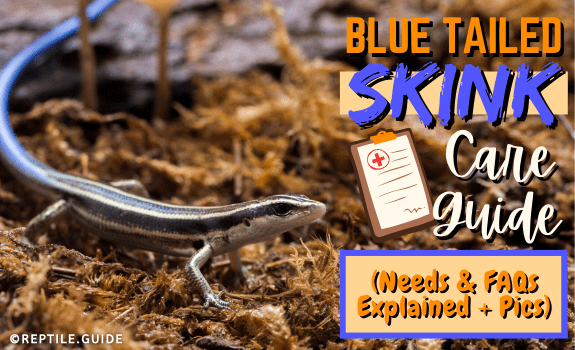Blue tailed skinks are eye-catching, short-limbed lizards that are easy to keep.
There are a few different species known as blue-tailed skinks that people keep as pets.
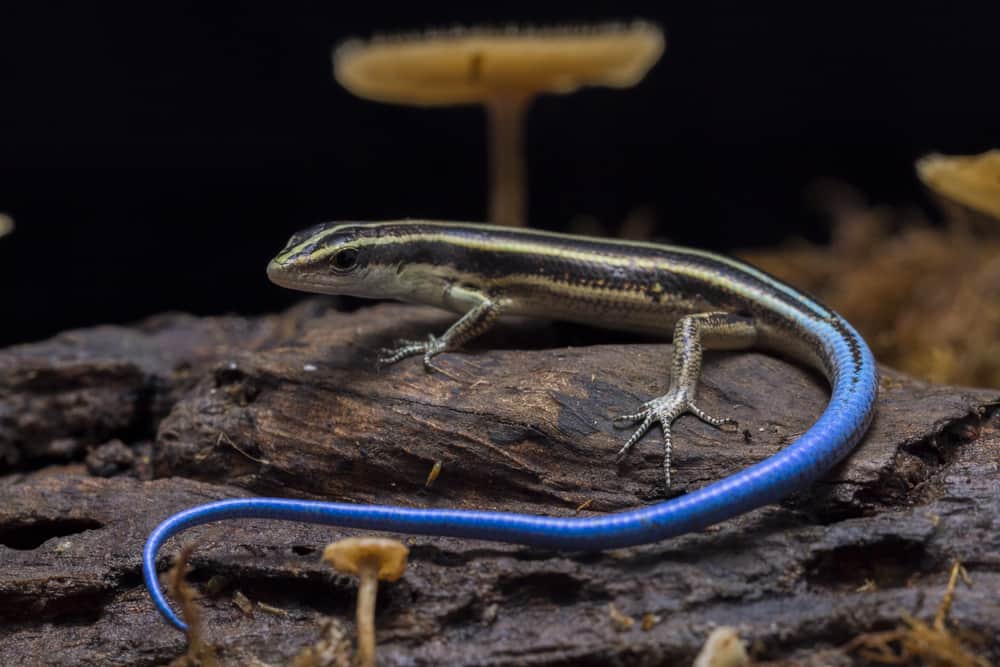
We’ll discuss the Pacific blue-tailed skink, Emoia caeruleocauda, and the American blue-tailed skink, Plestiodon fasciatus.
For both species you must:
- Provide branches and vegetation.
- Provide a light source and basking spot.
- Feed calcium-dusted and gut-loaded insects.
- Provide water, use a mister, and keep humidity correct.
- Keep adult blue-tailed skinks in a terrarium of at least 20 gallons per one skink.
In This Article
Background Information
The Pacific blue-tailed skink and American blue-tailed skink are different species of skink, but overlap in many ways.
They have similar diets, habitat requirements, humidity, and temperature needs.
We’ll discuss the basic biology of these two species and mention if there are differences in what they require as pets.
Blue-Tailed Skinks vs Five-Lined Skinks
People also call the American blue-tailed skink the five-lined skink.
Both the Pacific blue-tailed skink and the five-lined skink are known as blue-tailed skinks.
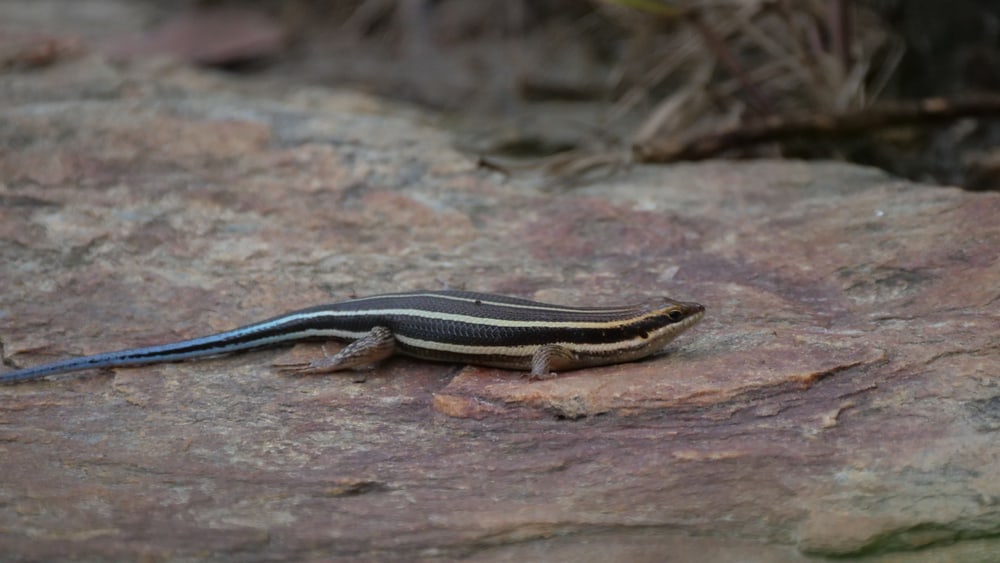
They’re similar in appearance and biology.
Blue Tailed Skink Range and Lifespan
Pacific blue-tailed skinks are native to Indonesia and Australia.
This species lives on the Solomon Islands, Vanuatu, Mariana Islands, the Philippines, and New Guinea.
The Pacific blue-tailed skink has a lifespan of about 7 years.
American blue-tailed skinks occur in the United States as far west as Missouri and as far south as Florida.
They also occur in southern parts of Canada.
You can also find them in the central states of Texas, Oklahoma, and Kansas. These skinks can live for up 6 years in the wild.
Both types of skink can live for up to 10 years in captivity.
Physical Description
You can recognize a blue-tailed skink by its bright blue tail and light stripes.
The stripes are cream-colored and run along the back of the skink’s body and down the sides, from snout to tail.
For both species, the stripes on the back of adults fade in time. The general body color ranges from gray to dark brown or black.
The American blue-tailed skink has five stripes that come together on the head.
The stripes on the Pacific blue-tailed skink don’t come together in the head region.
Juvenile American blue-tailed skinks have bright blue tails, while adults are duller.
In these skinks, the tail changes from a blue color to a grayish brown at sexual maturity.
These blue-tailed skinks have smooth, overlapping, and glossy scales on the body.
In the Pacific blue-tailed skinks the stripes fade with maturity. This makes them easy to confuse with other skinks like the Indonesian brown skink.
Pacific blue-tailed skinks have more than one color morph. One morph has an emerald green tail and the other morph is dark in color.
Why Do These Skinks Have a Bright Blue Tail?
The reason for the bright blue tail in young skinks is it focuses a predator’s attention on the tail.
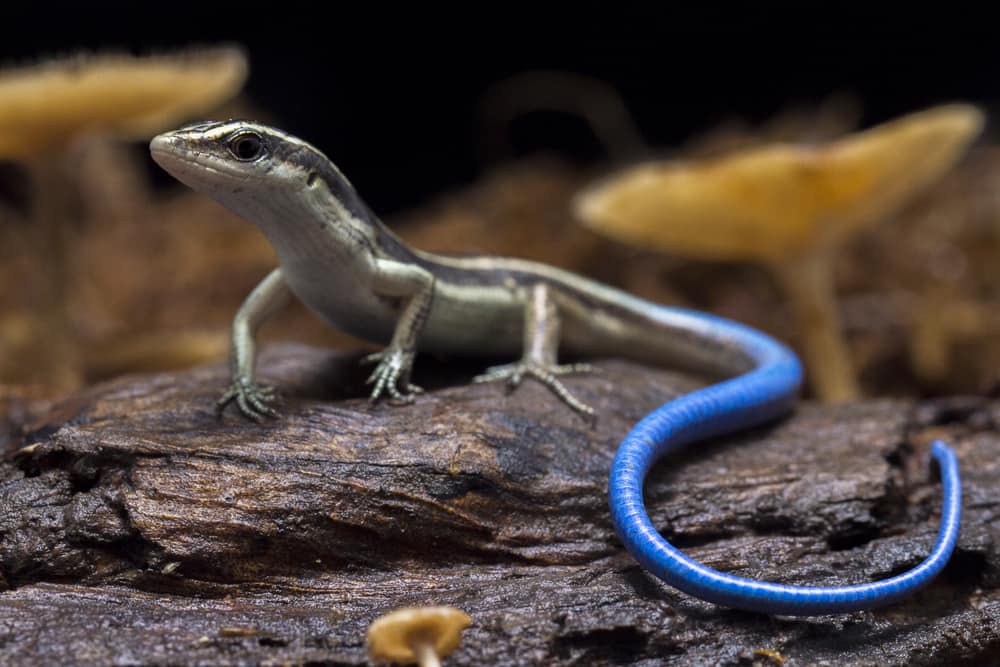
Skinks can intentionally lose their tails. This allows the skink to escape when a predator grabs it by the tail.
The tail will grow back (though usually smaller and paler) and the skink will live another day.
This is a common predator avoidance strategy among the Scincidae (skink) and Lacertidae (wall lizard) families.
How Big Do Blue-Tailed Skinks Get?
The Pacific blue-tailed skink is quite small at about 6 inches in length.
It has a small body relative to its tail, which makes up about 60% of the total length of the body.
American blue-tailed skinks are slightly bigger and can reach up to 8.5 inches in length. Smaller individuals only reach five inches.
In both species, adult males are similar in size to adult females if you look at the snout to vent length.
Pacific blue-tailed skinks show sexual dimorphism.
The male has a longer and wider head than the female. In some reptiles there may be gender differences in the scale patterns.
There’s no noticeable difference in the pattern of scales between sexes in this species.
The male American blue-tailed skink also has a bigger, wider head than the female.
Blue Tailed Skink Buying Tips
When you’re buying a blue-tailed skink, look for reputable reptile breeders in your area.
Reptile conventions and expos also offer excellent opportunities for buying.
These options are safer than buying from a pet shop. A pet shop may not have animals in top condition.
DON’T catch skinks in the wild. It’s bad for the natural population because it reduces population size.
Wild-caught individuals may also carry parasites. When buying a skink, first check the condition of the skink.
Check for the following signs of a healthy animal:
- Clean vent area
- An active and alert skink
- No ticks or mites on the body
- Clear eyes that don’t look cloudy
- Clean mouth and nose with no discharge
What Do Blue-Tailed Skinks Eat?
Blue-tailed skinks feed on a wide variety of insects but they also consume other arthropods and even small vertebrates.
They catch insects like:
- Flies
- Beetles
- Locusts
- Crickets
- Grasshoppers
They sometimes also eat isopods and millipedes.
The Pacific blue-tailed skink will also eat the occasional piece of fruit, but 90% of the diet consists of live insects and arthropods.
The larger five-lined skinks can eat small lizards or even baby mice, and invertebrates like spiders and earthworms.
Blue-Tailed Skink Diet
In captivity feed your skink various arthropods, including live insects.
Feed your blue-tailed skink the following live foods:
- Crickets
- Dubia roaches
- Earthworms
- Mealworms
- Waxworms
- Drosophila fruit flies
It’s best to choose crickets or roaches because mealworms and waxworms aren’t as nutritious.
Waxworms have a high fat content (over 20%) as do mealworms (9%). You should feed hatchlings, and very young skinks, fruit flies or baby crickets.
As the skink grows bigger you can switch to larger-sized prey items.
You can order different size insects to suit the size and age of your skink.
This is particularly true with crickets. You can choose from pinhead size up to full adult size crickets.
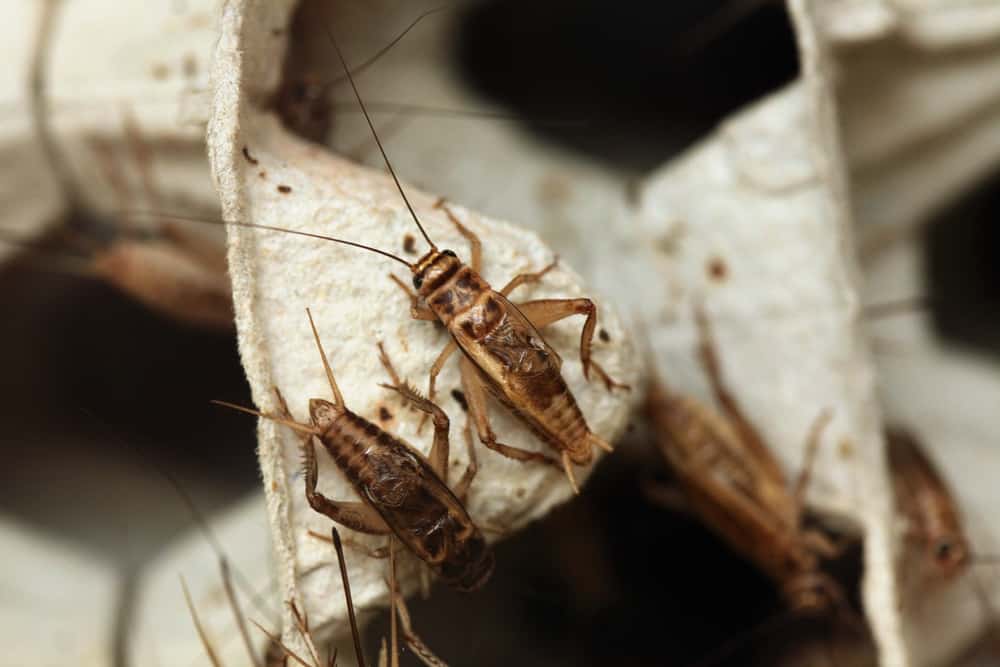
Crickets and roaches are excellent sources of protein. The protein content of both these insects is about 19 to 20%.
Feed your skink about as much live food as they will consume in five minutes. Use gut-loaded insects for food.
Pro Tip: Gut loading is when you let your feeder insects feed on nutritious foods before offering them to your reptile.
You can buy commercial gut loading food for crickets or feed them nutritious and mineral-rich foods.
For crickets, this includes feeding pieces of vegetables that are rich in vitamins.
Before feeding insects, dust them with an appropriate calcium powder.
Lizards need a 2:1 ratio of calcium to phosphorus. Calcium and vitamin D3 are important for healthy bones.
It also prevents the skinks from getting metabolic bone disease.
Purchase live insects from a supply company.
Don’t feed insects or any bugs you catch yourself because of the risk of pesticide contamination.
Wild arthropods may also carry illnesses or parasites that can sicken your skink.
Blue-Tailed Skink Habitat and Tank Setup
In the wild, blue-tailed skinks live in hardwood forests, on the edges of thick bush, and in rocky places. You can find them on:
- The ground
- In trees
- On logs
- In brush piles
- Under leaves
Blue-tailed skinks tend to be more arboreal when in open woodland areas where there’s less ground cover where they can hide from predators.
These skinks like to bask on piles of brush and logs. Blue-tailed skinks prefer some moisture.
We’ll point out where there are specific captive care differences in these two species of skink.
You should aim to create a natural-looking environment for your animal where it can exercise and hide.
Terrarium Setup
You can use a glass aquarium with a lid as a terrarium.
You can purchase an aquarium or wooden terrarium at a pet store BUT also buy a proper mesh lid that fits.
Your skink can live in a 10-gallon terrarium if it’s very small, but as it grows you need to consider a bigger home of between 20 and 30 gallons.
A good rule of thumb is to offer 20 to 25 gallons of space per skink.
You need more space if you have more than one skink to prevent conflict.
Adult males fight with other males so don’t house them together. Aggressive male-on-male behavior can lead to injuries like bite-wounds.
You can keep one male with several females since males are polygamous.
Use coconut fiber, humus, or orchid bark for the substrate in the terrarium.
Provide a few inches of the substrate so the skink can burrow down if it wants to.
Place plants, logs, bark, and rocks into the habitat to provide places for the skinks to sit and as hiding places.
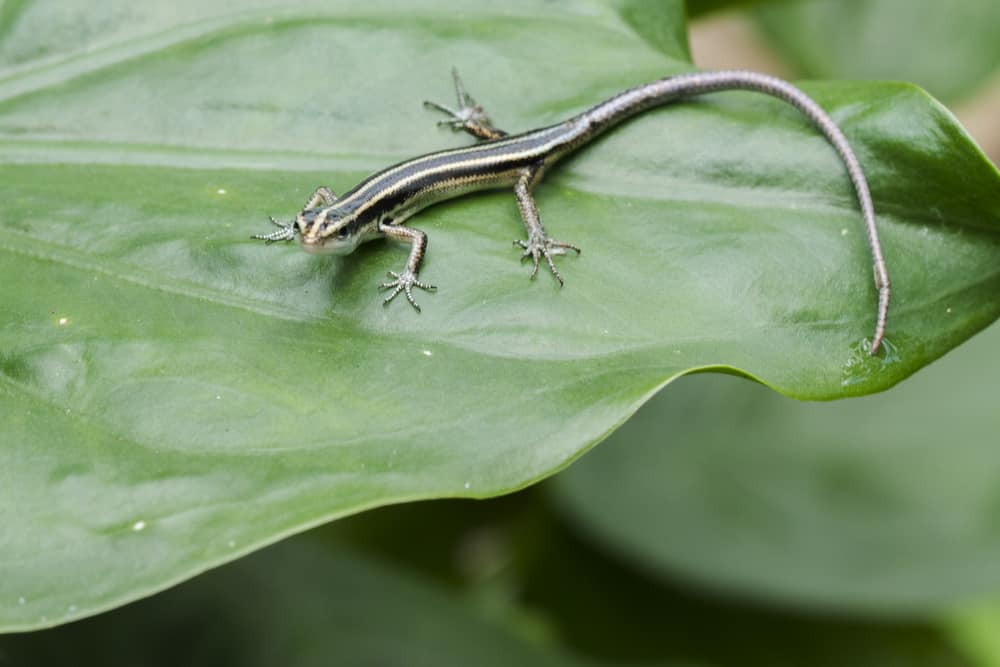
Expert Tip: Use live plants rather than plastic plants to create a natural environment.
Clean the terrarium you use for your skink at least once a month, but preferably more often.
A dirty habitat will likely make your skink sick. Use a reptile disinfectant when cleaning the terrarium.
Heat, Light, and Humidity
Place a heating lamp on one side of the terrarium.
This ensures there’s a temperature gradient so the skink can move to where it feels most comfortable.
Check temperature regularly by using a thermometer placed on the side of the terrarium.
It’s best to have a thermometer on each end to monitor both the cool and warm temperatures.
The temperature on the cool end of the habitat should be lower than under the heat lamp.
This way, the skink can move around to regulate its temperature.
Optimal temperatures differ slightly depending on the species.
Temperatures should be between 72oF and 82oF for an American blue-tailed skink or 77oF to 82oF for a Pacific blue-tailed skink.
The basking spot should be between 90oF and 95oF for a Pacific blue-tailed skink, while for an American blue-tailed skink it should be at 110oF.
Place a flattened stone or log near the lamp as a basking spot for your skink.
The skinks need between 10 and 12 hours of light a day provided by a proper UVB light.
UVB provides the animal with the needed vitamin D3 and helps it metabolize calcium. Using a timer on the light makes the system easier to use.
The humidity in the terrarium should be between 60% to 80%. During the day relative humidity can range up to 70% and at night, up to 80%.
Inadequate humidity leads to problems with shedding, compromising the health of the skink.
Provide water in a small bowl. You can use a reptile fogger to help maintain the humidity levels.
Your skink may also like to drink droplets of water that have sprayed onto vegetation in the aquarium.
Expert Tip: We recommend using distilled water (which is chlorine-free) to prevent harming your blue-tailed skink.
Breeding
Male skinks use courtship behavior, chemical cues and vision to locate females.
Blue-tailed males will fight rival males during the breeding season.
Skinks also have good enough vision that they can tell if another blue-tailed skink is a male or female.
Both species of blue-tailed skinks are polygamous, meaning that a male will breed with many females.
This is a reproductive strategy that has evolved in animals to increase their chance of leaving offspring.
Fun Fact: Blue-tailed skink males often have harems.
The Pacific blue-tailed skink lays 2 to 6 eggs in a nest made by burrowing into the substrate, and their eggs are about 2 cm in length.
The American blue-tailed skink lays between 5 to 13 eggs in a nest. made in decaying logs or in a cavity in mulch or bark.
The eggs are oval and have an average length of 1.3 cm.
The female American blue-tailed skink lays eggs about a month after breeding begins and the eggs hatch 4 to 6 weeks later.
Five-lined skinks start their breeding season in May every year.
Pacific blue-tailed skinks breed year-round. We don’t know if this species broods its clutch until hatching.
The female American blue-tailed skink shows brooding behavior and protects her eggs by coiling her body around them.
She changes position while brooding to ensure the eggs do not dry out.
Female skinks sometimes eat their eggs. This happens if eggs aren’t viable and start to rot.
The American-blue tailed skink females often cooperate in guarding eggs and may nest together in the same log.
Male American blue-tailed skinks mate with females but don’t demonstrate any brooding of the eggs or care of young skinks.
Their strategy is to mate with as many females as possible.
The female shows no parental care for newly hatched skinks even though she cares for the unhatched eggs.
Expert Tip: If you breed skinks in captivity separate adults from hatchlings to avoid cannibalism.
Blue-Tailed Skink Behavior
These skinks have diurnal habits so you won’t find them active at night. They avoid predators by running away and hiding.
There are ways for a skink to escape if caught. The best strategy they have is autotomy of the tail.
The blue-tailed skink can autotomize its tail (lose its tail) if caught by a predator. The tail grows back like for other skinks and lizards.
The skinks show territorial behavior and will act aggressively towards conspecific (same species) males.
Are Blue-tailed Skinks Poisonous?
Blue-tailed skinks AREN’T known to be poisonous BUT some species of blue-tailed skinks can sicken a predator.
There are records of cat predators who became ill after eating five-lined skinks.
These skinks aren’t venomous, though. Their bite can’t kill you or make you sick.
Do Blue-tailed Skinks Bite?
Pacific blue-tailed skinks are prone to drop the tail if handled too roughly.
American blue-tailed skinks can bite if they cannot escape and feel provoked.
They AREN’T aggressive animals but will defend themselves from a perceived attack.
NONE of the blue-tailed skinks are venomous so a bite may be annoying but not dangerous to humans.
Blue-Tailed Skink Health Information
For skinks in captivity, metabolic bone disease can occur from a lack of calcium and vitamin D3.
Bite injuries can happen if you keep several males together. Skinks may become obese if fed too many waxworms which are high in fat.
Wild skinks also carry parasites including ticks.
The American blue-tailed skink carries ticks that transmit Lyme disease. This is one more reason why you should not collect skinks from the wild!
The Emoia species can carry worm parasites. In the wild, Pacific blue-tailed skinks carry tapeworms.
In the wild predators such as snakes, birds, or small mammals, commonly attack skinks.
Domestic cats prey on skinks.
To keep your blue-tailed skink healthy, do the following:
- Clean the terrarium often.
- Supply clean water every day.
- Don’t feed more than the skink can eat.
- Gut-load and use calcium dust for live food.
- Maintain the temperature in the correct range.
- Remove any uneaten insects from the terrarium.
Regularly check on your skink. Ensure your skink doesn’t look underweight or act differently from normal.
If there’s a change in your animal’s appearance or behavior, it might be a sign of illness.
You can keep a blue-tailed skink in a 20 to 25-gallon aquarium using substrates like bark or mulch.
Place plants and rocks into the terrarium for hiding places.
Feed gut-loaded live insects like crickets and Dubia roaches. You may want to also read about the blue tongued skink.
And the pink-tongued skink is a more beginner-friendly species you might want to consider.
Or you could check out the largest skink species discovered: the monkey-tailed skink.
Do you have a blue-tailed skink, or are you planning on getting one? Let us know in the comments below.
